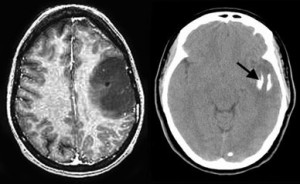Introduction
Oligodendrogliomas are uncommon gliomas.
- They arise from glial cells called oligodendrocytes. These cells are a normal constituent of the brain but much less common than astrocytes.
‘We offer a multidisciplinary management of oligodendroglioma, with experts in neurosurgery, radiation oncology and neuro-oncology working closely together to assure the highest quality of care’.
Symptoms
- Seizures occur in 50 percent to 80 percent off patients.
- Other symptoms include headache, nausea and vomiting, ataxia (difficulty with balance), dizziness and altered mental state
Diagnosis
- Magnetic resonance imaging (MRI) is the preferred diagnostic tool, although computed tomography (CT) is important as well to document whether calcifications exist.
- An actual tissue biopsy is typically required for definitive diagnosis in nearly all cases.
Treatment
- Surgery
- We will determine how much of the tumor can or should be removed. If the tumor is surgically accessible, a “complete” removal is attempted.
- Sometimes, oligodendroglioma are best removed with the aid of neuronavigation surgery, allowing the most complete, safest surgery possible.
- Radiation therapy
- Radiation therapy may be considered after surgical removal.
- Chemotherapy
- We offer the latest in promising medical therapies.
- For anaplastic oligodendroglioma (a more aggressive type of oligodendroglioma), chemotherapy can be very effective if the tumor demonstrates certain chromosomal (gene) defects.








